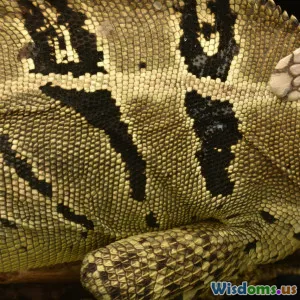
Comparing Sea Monster Legends Across Different Continents
9 min read Explore sea monster legends worldwide, revealing how myths reflect cultures and nature’s mysteries beneath the waves. (0 Reviews)
Comparing Sea Monster Legends Across Different Continents
The vast oceans have long been the cradle of imagination and mystery. From the frothy waves of the Atlantic to the deep blue expanse of the Pacific, the sea has inspired some of the most enduring legends — especially those of monstrous creatures lurking beneath the surface. This article dives deep into the captivating universe of sea monster folklore from various continents, exploring how these legends not only satisfy human curiosity but also reflect deep cultural beliefs and environmental encounters.
The Alluring Mystery of Sea Monsters: A Global Phenomenon
Ever since humans began venturing onto open waters, the ocean has been both a provider and a threat. It supplies food and trade routes but also harbors unpredictability and terror. Sea monster myths emerged as a natural response to unexplained phenomena: massive whale sightings, mysterious reefs, and especially inexplicable ship disappearances. These stories filled the gaps in human knowledge, often exaggerating real creatures or natural occurrences into supernatural beings.
Notably, similar types of creatures appear in legends across different continents, suggesting common psychological or ecological factors at play. Let’s embark on a cross-continental exploration.
European Legends: The Kraken and Leviathan
The Kraken
The Kraken, likely one of the best-known sea monsters in Western lore, originates mainly from Norse and Scandinavian folklore. Described as a gargantuan octopus or squid-like creature, the Kraken was said to pull entire ships under the waves. Historical sources such as the writings of the 18th-century explorer Erik Pontoppidan fueled the legend, describing colossal tentacled beasts dwelling off the coasts of Norway and Greenland.
Interestingly, the Kraken myth might have originated from actual giant squid encounters — these real creatures can reach lengths up to 13 meters (43 feet), which would have made them terrifying foes to ancient sailors unfamiliar with their nature.
The Leviathan
In Judeo-Christian tradition, the Leviathan is depicted as a giant sea serpent or dragon symbolizing chaos and evil. Mentioned in texts such as the Bible and the apocryphal Book of Job, the Leviathan embodies the untameable forces of nature. Its fire-breathing and impenetrable scales are metaphors for natural disasters and the seemingly infinite power of the sea.
This legend, reaching far back into antiquity, reinforced the concept of the ocean as a domain beyond human control — a motif mirrored in many other cultures.
Asian Sea Monsters: The Makara and Nure-onna
The Makara
In Hindu and Buddhist iconography, the Makara is a hybrid sea creature often depicted bearing elements of a crocodile, fish, and elephant. It is considered a guardian of gateways, a mythical sea creature symbolizing both protection and abundance. Unlike the fearsome Kraken, the Makara is more benevolent, representing the sea’s life-giving properties.
The Makara also appears extensively in temple art across South and Southeast Asia, indicating its religious significance and how mythology intertwined with societal values.
The Nure-onna
Japanese folklore introduces the Nure-onna, a snake-like sea monster with the head of a woman. Stories tell of the Nure-onna preying on fishermen and swimmers near shores. These tales may symbolize the dangers inherent in coastal waters, wrapped in supernatural storytelling that warns of real-life maritime risks.
African Sea Monster Routes: Mami Wata and the Great Serpent
Mami Wata
In West and Central African folklore, Mami Wata is a widely venerated water spirit often depicted as a mermaid-like figure. Rather than terrifying sailors, Mami Wata embodies a complex range of themes from fertility and healing to seduction and danger. She represents the dual nature of water — needed for life yet capable of destruction and unpredictability.
European slave traders and local African cultures combined myths that resulted in Mami Wata’s present-day folklore, highlighting how legends morph with societal changes and historical interactions.
The Great Serpent
Various African coastal tribes also recount tales of giant sea serpents capable of capsizing boats or controlling the fate of communities near estuaries. Anthropological studies suggest such myths may derive from real encounters with large, elusive animals such as giant eels or anacondas.
The Americas: The Lusca and Cadborosaurus
Lusca
In the Caribbean, especially around the Bahamas, tales of the Lusca dominate sea monster folklore. Often described as a gigantic half-shark, half-octopus hybrid lurking in underwater caves and blue holes, Lusca legends infect the imaginations of locals and divers alike. These caves are known for strong currents and mysterious depths, which likely fed this myth.
Marine biologists have suggested that misidentified sightings of large squids, sharks, or even giant groupers could be behind the Lusca lore.
Cadborosaurus
Off the Pacific coast of North America, particularly British Columbia and Washington state, sightings are reported of Cadborosaurus, a serpentine sea creature thought to measure between 6 and 15 meters long. Named after Cadboro Bay, this elusive entity is described in eyewitness accounts as having long necks and horse-like heads, sparking comparisons to the Loch Ness Monster’s counterparts.
Efforts to scientifically identify such creatures have been inconclusive, keeping this legend alive and thriving among cryptid enthusiasts.
Common Threads and Cultural Reflections
Despite their geographic and cultural differences, sea monster legends share intriguing commonalities:
- Hybrid Physical Forms: Many creatures combine features of known animals — tentacles, serpents, fish heads — suggesting attempts to describe unknown realities by mixing familiar elements.
- Symbolic Representations: Sea monsters act as metaphors: for chaos, natural disasters, environmental dangers, or spiritual forces.
- Human Psychological Need: These legends emerged to intimidate, entertain, or teach lessons about respect for nature’s power.
Renowned marine biologist Dr. Sylvia Earle comments, "The sea has always been a subconscious frontier, where real and imagined creatures swim equally in the minds of those who depend on it."
Conclusion: Why Sea Monster Myths Endure
Sea monster legends are far more than fanciful tales. They are a window into humanity's attempts to grapple with nature's unknown, communicate cultural values, and imbue the mysteries of deep waters with meaning. Across continents, these myths harbor insights about human fear, respect, and imagination.
In an age where technology maps the ocean floor and biological breakthroughs uncover new marine species, the enduring popularity of sea monster legends is a reminder that mystery still thrives beneath the waves.
For modern readers, learning about these varied myths inspires appreciation not only for cultural diversity but for the fascinating mysteries still lurking in the deep.
Further Reading
- "The Kraken: When Myth Encounters Science" by Richard Ellis
- "Water Spirits of the World" by Elizabeth Gowing
- National Oceanic and Atmospheric Administration reports on historical sailor accounts
Embracing these ancient stories allows a connection to our ancestors’ wonder — an invitation to continue exploring the precarious line between myth and reality shimmering beneath the sea’s surface.
Rate the Post
User Reviews
Popular Posts





















